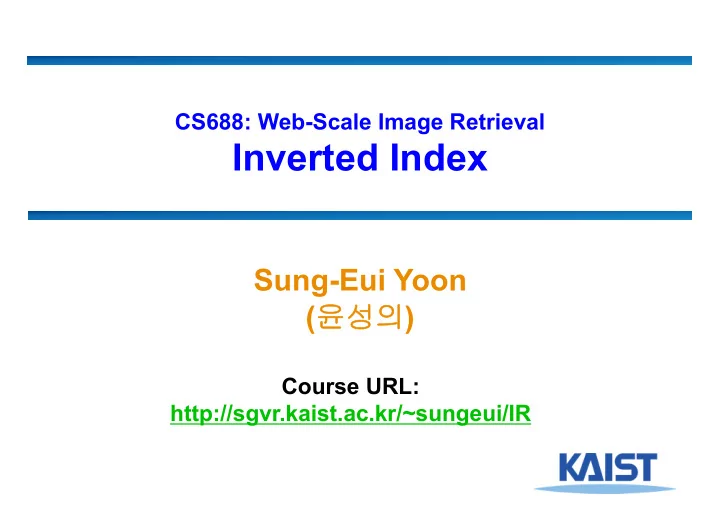

CS688: Web-Scale Image Retrieval Inverted Index Sung-Eui Yoon ( 윤성의 ) Course URL: http://sgvr.kaist.ac.kr/~sungeui/IR
Class Objectives ● Discuss re-ranking for achieving higher accuracy ● Spatial verification ● Query expansion ● Understand approximate nearest neighbor search ● Inverted index and inverted multi-index ● At the last class: ● Bag-of-visual-Words (BoW) models ● CNN w/ triplet loss (ranking loss) 2
Problems of BoW Model ● No spatial relationship between words ● How can we perform segmentation and localization? Ack.: Fei-Fei Li 3
Post-Processing or Reranking Query image Shortlist (e.g., 100 images) Database .. Re-ranking .. 4
Post-Processing ● Geometric verification ● RANSAC Matching w/o spatial matching (Ack: Edward Johns et al.) ● Query expansion query input DB results 5
Geometric Verification using RANSAC Repeat N times: e z z - Randomly choose 4 a matching pairs f e - Estimate transformation - Assume a particular Transform transformation (Homography) - Predict remaining e z z points and count a “inliers” f e 6 Ack.: Derek Hoiem (UIUC)
Homography ● Transformation, H, between two planes ● 8 DoF due to normalization to 1 7
Pattern matching ● Drones surveying city ● Identify a particular car 8
Image Retrieval with Spatially Constrained Similarity Measure [Xiaohui Shen, Zhe Lin, Jon Brandt, Shai Avidan and Ying Wu, CVPR 2012] 9
Learning to Find Good Correspondences, CVPR 18 ● Given two sets of input features (e.g., SIFTs), return a prob. of being inliers for each feature ● Adopt the classification approach being inlier or not ● Consider the relative motion between two images for the loss function 10
Query Expansion [Chum et al. 07] Expanded results that were Top 4 images not identified by the original Original query query 11
Efficient Diffusion on Region Manifolds, CVPR 17 & 18 ● Identify related images by the diffusion process, i.e., random walks ● Perform random walks based on the similarity between a pair of images ● Utilize k-Nearest Neighbor (NNs) of the query images 12
Inverted File or Index for Efficient Search ● For each word, list images containing the word feature space Inverted File Near cluster … search Shortlist Re-ranking Ack.: Dr. Heo 13
Inverted Index Construction time: • Generate a codebook by quantization – e.g. k-means clustering Figure from Lempitsky’s slides • Build an inverted index 𝑥𝑝𝑠𝑒 � 𝑗𝑒 𝑗𝑒 𝑗𝑒 … 𝑗𝑒 – Quantize each descriptor 𝑥𝑝𝑠𝑒 � 𝑗𝑒 𝑗𝑒 𝑗𝑒 into the closest word … – Organize desc. IDs in terms inverted index 𝑥𝑝𝑠𝑒 � 𝑗𝑒 𝑗𝑒 of words Ack.: Zhe Lin 14
Inverted Index Query time: • Given a query, – Find its K closest words – Retrieve all the data in the K lists corresponding to the words • Large K – Low quantization distortion – Expensive to find kNN words Ack.: Zhe Lin 15
The inverted index "Visual word" Sivic & Zisserman ICCV 2003 Visual codebook
Approximate Nearest Neighbor (ANN) Search ● For large K ● Takes time to find clusters given the query ● Use those ANN techniques for efficiently finding near clusters ● ANN search techniques ● kd-trees: hierarchical approaches for low- dimensional problems ● Hashing for high dimensional problems; will be discussed later with binary code embedding ● Quantization (k-means cluster and product quantization) 17
kd-tree Example ● Many good implementations (e.g., vl-feat) 18
Querying the inverted index Query: • Have to consider several words for best accuracy • Want to use as big codebook as possible conflict conflict • Want to spend as little time as possible for matching to codebooks Ack.: Lempitsky
Inverted Multi ‐ Index [Babenko and Lempitsky, CVPR 2012] • Product quantization for indexing • Main advantage: – For the same K, much finer subdivision – Very efficient in finding kNN codewords Ack.: Lempitsky 20
Product quantization 1. Split vector into correlated subvectors 2. use separate small codebook for each chunk Quantization vs. Product quantization: For a budget of 4 bytes per descriptor: 1. Use a single codebook with 1 billion codewords or many minutes 128GB 2. Use 4 different codebooks with 256 codewords each < 1 millisecond 32KB Ack.: Lempitsky
Performance comparison on 1 B SIFT descriptors 100 x K = 2 14 Time increase: 1.4 msec ‐ > 2.2 msec on a single core (with BLAS instructions) Ack.: Lempitsky
Retrieval examples Exact NN Uncompressed GIST Multi ‐ D ‐ ADC 16 bytes Exact NN Uncompressed GIST Multi ‐ D ‐ ADC 16 bytes Exact NN Uncompressed GIST Multi ‐ D ‐ ADC 16 bytes Exact NN Uncompressed GIST Multi ‐ D ‐ ADC 16 bytes Ack.: Lempitsky
Scalability ● Issues with billions of images? ● Searching speed inverted index ● Accuracy larger codebooks, spatial verification, expansion, features ● Memory compact representations ● Easy to use? ● Applications? ● A new aspect? 24
Class Objectives were: ● Discuss re-ranking for achieving higher accuracy ● Spatial verification ● Query expansion ● Understand approximate nearest neighbor search ● Inverted index ● Inverted multi-index 25
Next Time… ● Hashing techniques 26
Homework for Every Class ● Go over the next lecture slides ● Come up with one question on what we have discussed today ● 1 for typical questions (that were answered in the class) ● 2 for questions with thoughts or that surprised me ● Write questions 3 times 27
Figs 28
Inverted Index Inverted index 𝑑𝑚𝑣𝑡𝑢𝑓𝑠 𝑗𝑒 𝑗𝑒 𝑗𝑒 … 𝑗𝑒 � 𝑑𝑚𝑣𝑡𝑢𝑓𝑠 𝑗𝑒 𝑗𝑒 𝑗𝑒 � … 𝑑𝑚𝑣𝑡𝑢𝑓𝑠 𝑗𝑒 𝑗𝑒 � Ack.: Zhe Lin 29
Recommend
More recommend